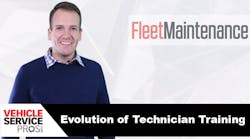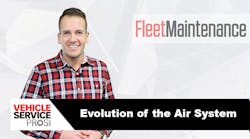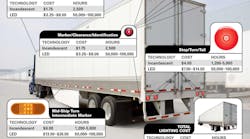There are some significant differences between incandescent and LED vehicle lighting technology, including adapting the servicing of these systems. Continuing his discussion on the changes to vehicle lighting technologies, Brett Johnson, president and CEO of Optronics International, discusses the evolution of maintenance upkeep and training programs for today’s vehicle lighting systems.
Transcription of interview:
Erica Schueller, Fleet Maintenance: Welcome to VSP News: Uptime Update. I am your host Erica Schueller, Editor-in-Chief of Fleet Maintenance magazine, covering all maintenance, all vehicle classes, all management, all the time.
In a recent episode of Uptime Update, we talked with Brett Johnson, president and CEO of Optronics International, about changes to commercial vehicle lighting technology in the last several years, including the continued adoption of LED vehicle lighting technology.
I followed up with Johnson to discuss some of the challenges fleets might face when it comes to servicing LED lamps, versus the traditional incandescent lamps, and how Optronics is working to address these challenges.
Brett Johnson, Optronics International: There are new challenges with the advent of LED lighting. That primarily revolves around the fact that LED lighting is so much more robust than incandescent lighting. Where you might get a 2,500-hour service life out of an incandescent light, you get 50,000 to 100,000 hours out of an LED light.
Where that’s particularly a challenge is in corrosion prevention. What we often say in lighting and electrical is “it’s all about the corrosion.”
Optronics has addressed that issue with the development of the SuperLamp. The SuperLamp basically addresses or prevents corrosion in two ways: it stops contaminants on the outside from getting into the light, and we’ve designed the circuitry so that it will prevent corrosion if contaminants do get within the light.
Schueller, Fleet Maintenance: Johnson shares a few more details on how the SuperLamp product works.
Johnson, Optronics International: Lamps can be exposed to a wide variety of environmental contaminants. The SuperLamp was specifically designed to resist 45 specific chemical agents. These 45 agents can be classified into engine fluids, cleaning fluids and environmental contaminants.
The SuperLamp uses a unique, patented coating that bonds with the lens and the housing to completely cover the light to offer that type of protection.
The SuperLamp technology is currently used in pilot programs by several OEMs, and it's recently been selected as the standard lighting package on all Class 8 Peterbilt tractors.
Schueller, Fleet Maintenance: Vehicle lighting and electrical systems go hand-in-hand. Technician training is critical for servicing vehicle lighting on commercial vehicles. Johnson talks about options available for helping fleets train their technicians to service this vehicle component category.
Johnson, Optronics International: Optronics has developed the Bright Ideas technical training program, whose sole purpose is to reduce exposure to CSA (Compliance, Safety, Accountability) violations.
The Bright Ideas technical training program is a comprehensive program that addresses basic electrical, lighting, harnessing, connections, as well as installation, within the context of federal law and regulations, as well as CSA.
Schueller, Fleet Maintenance: What can we expect in the future as it relates to vehicle lighting maintenance and replacement, as well as vehicle lighting in general? Johnson shares his insights.
Johnson, Optronics International: In the longer term, the real question is “how are we going to utilize technology or lighting technology to deliver the optimal lighting environment?"
There is a clear correlation between lighting and mood, health and physiology.
When we learn more about that deep connection, the better we will be able to deliver that optimal lighting environment.
Suffice it to say, the world is not going to slow down. We need science to help us develop and create the perfect balance between health and safety in the lighting environment.
Schueller, Fleet Maintenance: If you’d like to read more information about best practices for maintenance and upkeep on vehicle lighting systems, check out the October 2018 Fleet Maintenance Cover Story on this topic by going to the link below.
Thank you for tuning in to VSP News: Uptime Update, I’m your host Erica Schueller.
Until our next broadcast, keep up with this, and other industry topics, by visiting us online at VehicleServicePros.com.
Read more about best practices for maintenance and upkeep on vehicle lighting systems.


